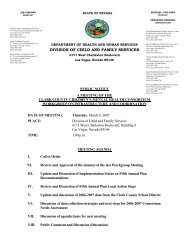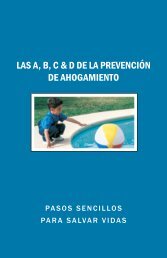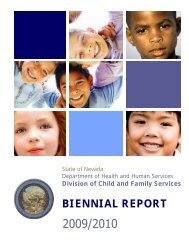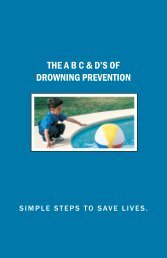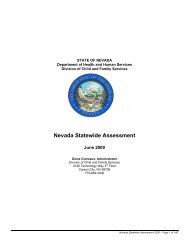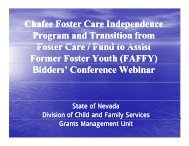STATE OF NEVADA - Division of Child and Family Services
STATE OF NEVADA - Division of Child and Family Services
STATE OF NEVADA - Division of Child and Family Services
Create successful ePaper yourself
Turn your PDF publications into a flip-book with our unique Google optimized e-Paper software.
This item refers to quality st<strong>and</strong>ards. These st<strong>and</strong>ards for foster care fall into several categories including statute,<br />
regulation <strong>and</strong> statewide policy. These categories include child protection <strong>and</strong> foster care; licensure <strong>of</strong> foster care homes,<br />
residential facilities <strong>and</strong> foster care agencies; <strong>and</strong> out-<strong>of</strong>-state placements. To ensure child protection while in foster<br />
care, child welfare agencies must oversee <strong>and</strong> monitor the placement <strong>of</strong> children in foster homes or residential facilities<br />
pursuant to the <strong>Child</strong> Protection Statutes (NRS <strong>and</strong> NAC 432B), Foster Care Statutes (NRS <strong>and</strong> NAC 424) <strong>and</strong> statewide<br />
policies, such as out-<strong>of</strong>-home placement (Policy Chapter 1000); training, assessment, <strong>and</strong> licensing (Policy 1004), <strong>and</strong><br />
case planning (Policy 0204); that outline requirements for quality st<strong>and</strong>ards. These regulations <strong>and</strong> policies embody<br />
elements <strong>of</strong> quality service delivery, such as the consideration <strong>of</strong> cultural differences, timeliness, safety, visitation location,<br />
placement preference, scheduling <strong>of</strong> medical, dental <strong>and</strong> mental health needs. In addition, child welfare staff <strong>and</strong> child<br />
care facilities that provide services to foster children must meet personnel requirements for appropriate licensure <strong>and</strong><br />
training to work in various positions. Fingerprinting <strong>and</strong> a criminal background checks are m<strong>and</strong>atory in the State in order<br />
to work with children (NRS 432.100). Staff must have appropriate supervision <strong>and</strong> are monitored through regular<br />
evaluation <strong>of</strong> work performance st<strong>and</strong>ards. The law <strong>and</strong> regulations also designate the number <strong>of</strong> children that may be<br />
placed in a foster care home or group home <strong>and</strong> the physical requirements for the home or facility. These measures are<br />
intended to ensure that quality services are provided to children in foster care by child welfare agency staff. The law <strong>and</strong><br />
regulations designate the number <strong>of</strong> children that may be placed in a foster care home or group home.<br />
The st<strong>and</strong>ards for placement in a facility outside <strong>of</strong> the State <strong>of</strong> Nevada are established <strong>and</strong> monitored by the Out-<strong>of</strong>-State<br />
Placement Committee. Monthly visitation <strong>and</strong> monitoring by the local child welfare agency are required <strong>and</strong> an annual<br />
rigorous on-site facility review must be conducted by the State. <strong>Child</strong> Care facilities statutes <strong>and</strong> regulations (NRS 432A,<br />
NAC 432A) outline requirements for the protection <strong>of</strong> health <strong>and</strong> safety <strong>of</strong> children in facilities (educational, shelter care,<br />
<strong>and</strong> residential), <strong>and</strong> provides st<strong>and</strong>ards for child care including the provision <strong>of</strong> qualified service providers. These<br />
regulations include the provision <strong>of</strong> ensuring that no child under the age <strong>of</strong> six is placed in a congregate care facility.<br />
In addition, the expectations for a foster parent’s care <strong>and</strong> treatment <strong>of</strong> a child is contained in regulations (NAC 424.495-<br />
.610) where authority is given to the foster parent to administer appropriate discipline <strong>and</strong> supervision, but limitations are<br />
imposed to guarantee the safety <strong>and</strong> health <strong>of</strong> the child. The care <strong>and</strong> treatment <strong>of</strong> a foster child in care is monitored by<br />
the caseworker’s monthly home visitation which requires time spent alone with the child. The caseworker <strong>and</strong> licensing<br />
authority work together to cross-report any activity that may impact the safety or health <strong>of</strong> child in placement. The<br />
monitoring <strong>of</strong> a single foster home or group home setting <strong>and</strong> a facility follow similar procedures <strong>and</strong> may involve other<br />
agencies or types <strong>of</strong> expertise as indicated.<br />
In the 2009 Legislature, AB227 was enacted. This bill revises provisions relating to the provision <strong>of</strong> foster care. This will<br />
help develop st<strong>and</strong>ards <strong>of</strong> performance for the Foster Care Agencies, <strong>and</strong> to help differentiate between a Specialized<br />
Foster Home <strong>and</strong> a Regular Foster Home. This bill became effective May 29, 2009 for the purpose <strong>of</strong> adopting regulation<br />
<strong>and</strong> January 1, 2011, for all other purposes. A new workgroup was formed in the current fiscal year to draft the<br />
regulations for this bill. The drafted regulations will be submitted by July 1, 2010 to the Nevada Legislative Council<br />
Bureau. If approved, the regulations will become effective January 1, 2011.<br />
The 2009 Nevada CFSR report rated this item as a strength, which is consistent with the ongoing work that has been<br />
done since this review.<br />
Item 31: Quality assurance system<br />
Goal: The State will ensure that an identifiable quality assurance system is in place in the State where the services<br />
included in the <strong>Child</strong> <strong>and</strong> <strong>Family</strong> <strong>Services</strong> Plan (CFSP) are provided, <strong>and</strong> that it evaluates the quality <strong>of</strong> services, identifies<br />
the strengths <strong>and</strong> needs <strong>of</strong> the service delivery system, provides relevant reports, <strong>and</strong> evaluates program improvement<br />
measures implemented.<br />
This goal has several objectives to ensure a model quality assurance system. The first objective is that the State will<br />
ensure continuous improvement <strong>of</strong> the quality assurance system <strong>and</strong> the State will utilize process evaluations <strong>and</strong><br />
stakeholder feedback for evaluating the effectiveness <strong>of</strong> individual case reviews conducted in each child welfare agency<br />
on an annual basis.<br />
To address this objective, the CFSP was developed so that each <strong>of</strong> the 23 Safety, Permanency <strong>and</strong> Well-Being<br />
Performance Indicators <strong>and</strong> 22 systemic factors has specific goals <strong>and</strong> objectives. Additionally, Quantitative UNITY<br />
Reports are in the process <strong>of</strong> being developed to supplement a qualitative case review process <strong>and</strong> will provide current<br />
data for each quarterly PIP report. Due to budget reductions, the State will be implementing a new targeted quality<br />
improvement case review (QICR) process to replace the previous system. Since March 2010, the State has been<br />
Nevada APSR – SFY 2010<br />
Page 51 <strong>of</strong> 108



